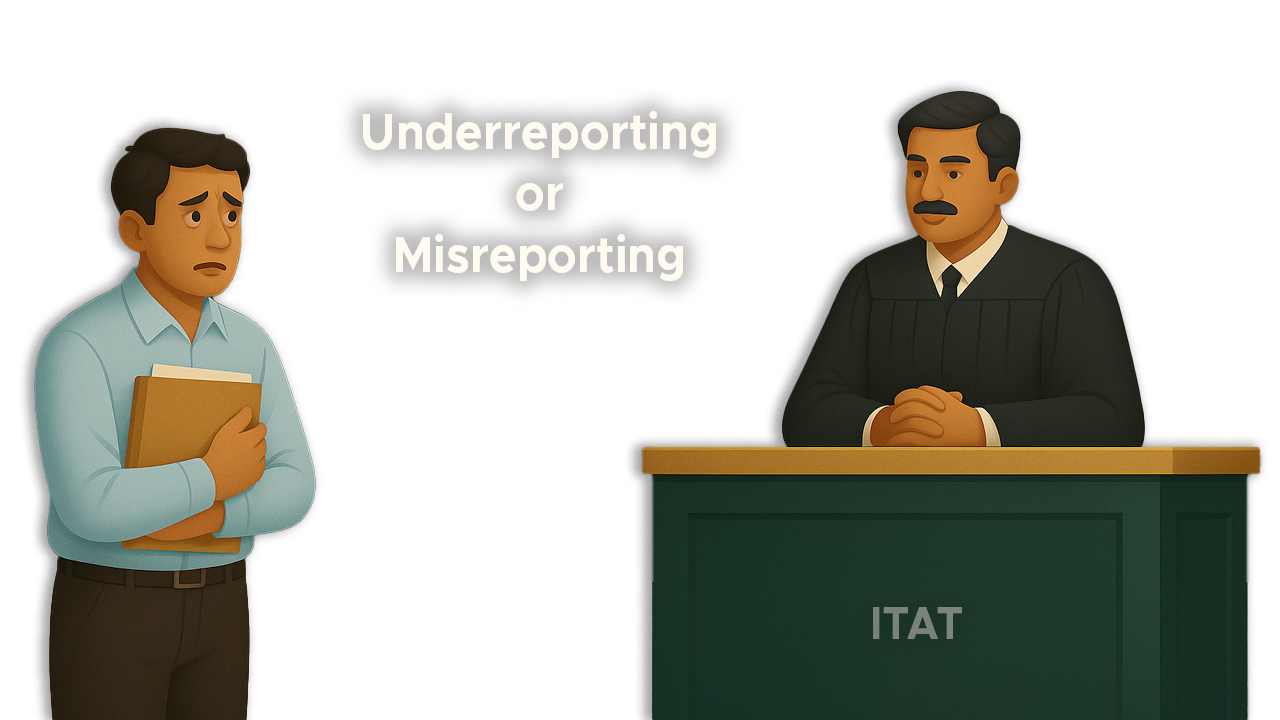Introduction
In the ever-evolving landscape of tax jurisprudence, where the letter of the law meets the complexities of real-world application, a recent judgment from the ITAT1, Pune Bench demands close attention. This article embarks on an in-depth examination of the pivotal decision in the case of Sachin Baban Shinde v. ITO, National Faceless Assessment Centre, Delhi2. At its heart lies a critical challenge: the imposition of a penalty under Section 270A of the Income Tax Act, 1961, specifically for income deemed underreported as a consequence of misreporting. What truly forms the analytical core of this report, however, is the Tribunal’s striking decision to set aside this penalty, despite the initial finding of misreporting. This outcome compels us to delve into the nuanced interplay of taxpayer intent, professional reliance, and the judiciary’s discerning approach to penal provisions.
Legal Framework: Underreporting vs. Misreporting of Income
This pivotal provision was meticulously crafted to address and penalise instances of underreporting or misreporting income, with the overarching objective of deterring tax evasion and upholding the integrity of the fiscal system.
The Act draws a crucial distinction between two forms of non-compliance. Underreporting of Income typically occurs when the income assessed or reassessed by tax authorities surpasses the amount declared by the taxpayer in their return. This can also arise if no return has been furnished and the assessed income exceeds the basic exemption limit, or if a declared loss is subsequently reduced or converted into positive income during assessment. Importantly, underreporting can often stem from unintentional causes, such as an honest belief, a lack of complete knowledge, or even reliance on expert advice, painting a picture of error rather than malice.
Misreporting of Income, in stark contrast, is considered a far more severe offence. It implies a deliberate act of providing incorrect or misleading information concerning the type, source, or measurement of income. This category suggests intentional deceit or a willful attempt to evade tax, carrying a heavier implication of culpability.
To leave no room for ambiguity, Section 270A(9) meticulously enumerates specific circumstances that are statutorily deemed to constitute “misreporting of income.” These include: misrepresentation or suppression of facts; failure to record investments in the books of account; claiming expenditure not substantiated by any evidence; recording any false entry in the books of account; failure to record any receipt in books of account having a bearing on total income; and failure to report any international transaction or any specified domestic transaction as required by law. In the Sachin Baban Shinde case, the penalty was specifically imposed under Section 270A(8) for “underreporting of income in consequence of misreporting“, indicating the Assessing Officer’s belief that the assessee’s actions fell squarely within one of these stringent misreporting categories.
Adding another layer of complexity, Section 270AA of the Act provides a mechanism through which an assessee can apply for immunity from the imposition of penalty under Section 270A and the initiation of prosecution proceedings. The primary conditions for availing such immunity are straightforward: the payment of the tax and interest payable as per the assessment or reassessment order within the specified period, and the assessee refraining from filing an appeal against that assessment order.
However, a crucial limitation of Section 270AA emerges: immunity is generally not granted if the underreported income falls under any of the misreporting categories specified in Section 270A(9). This implies that if the AO has a specific finding of misrepresentation, false entries, or other forms of misreporting, the application for immunity may be rejected. Yet, judicial pronouncements have introduced a significant nuance, suggesting that immunity should not be denied merely on a general reference to “misreporting” if the notice initiating the penalty does not clearly specify how the ingredients of misreporting were satisfied. This emphasizes that the AO must establish the specific circumstances of misreporting, rather than simply labeling the income as such, demanding a higher standard of proof.
The strict conditions of Section 270AA, which deny immunity for misreporting, clearly reflect the legislative intent to treat deliberate misreporting with greater severity. Nevertheless, the ITAT’s decision in Shinde, deleting the penalty despite its initial levy for “misreporting,” suggests a judicial interpretation that prioritizes the absence of mens rea and the presence of bona fide actions over a mechanical application of misreporting categories. This implies that the underlying cause of the misreporting i.e. fraud by a consultant, lack of the assessee’s knowledge or intent can effectively mitigate the effect for penalty purposes. The ITAT implicitly found that the assessee’s actions, though resulting in misreporting, lacked the culpable intent typically required for a penalty under Section 270A, thereby offering a crucial layer of protection to the unsuspecting taxpayer.
From Liability to Resolution: How Voluntary Payment Changes the Tax Game
A critical factor that heavily influenced the ITAT’s decision in the Shinde case was the assessee’s proactive step of paying the due tax along with interest. This payment was made significantly prior to the issuance of the Section 148 notice. The Tribunal accepted the assessee’s argument that a revised return could not be filed voluntarily at that time because the statutory due date for filing the original return had already passed. This explanation clarified why the formal return was filed only in response to the notice. The ITAT found “force in the arguments” of the assessee’s counsel, acknowledging that the amount of tax and interest was deposited voluntarily much prior to the issue of the notice.
The ITAT’s significant emphasis on the pre-notice voluntary payment as a key factor for deleting the penalty establishes a strong judicial position favoring substantive compliance and proactive rectification over strict procedural adherence. This aligns with the broader spirit of penalty mitigation provisions found in other tax statutes, such as the Goods and Services Tax (GST) provisions where voluntary payment before notice can waive penalties. This approach incentivizes taxpayers to correct errors as soon as they are identified, even if formal deadlines have passed, thereby fostering voluntary compliance and potentially reducing the volume of tax litigation. The Tribunal’s decision to prioritise the voluntary payment over the timing of the revised return filing is a significant judicial interpretation. This implies a broader principle: if a taxpayer genuinely rectifies their position and pays the correct tax before formal enforcement action begins, the penalty should be waived. This is a crucial takeaway for taxpayers and tax authorities alike, as it encourages prompt self-correction.
Judicial Precedents: A Comparative Legal Perspective
The ITAT’s decision in Sachin Baban Shinde aligns with a consistent line of judicial pronouncements that emphasize the importance of mens rea and bona fide actions in penalty proceedings.
- Sri T. Ashok Pai v. Commissioner of Income Tax, Bangalore3: This landmark Supreme Court judgment, though dealing with Section 271(1)(c), established principles highly relevant to Section 270A. The Court held that if an assessee’s explanation for a mistake is treated as bona fide and it is found that they acted on wrong legal advice, the burden on the assessee is discharged, and penalty should not be levied. The Supreme Court emphasized that penalty orders are quasi-criminal, requiring the department to establish concealment, and that Mens rea is essential. A mere omission or negligence would not constitute a deliberate act of concealment. The acceptance of a revised return and the fault lying with the tax counsel were significant factors in this ruling. The SC affirmed the Tribunal’s finding that the assessee, who relied on his bank’s law agency for tax matters, acted bona fide and was not guilty of deliberate concealment. The Court underscored that the burden of proof in penalty proceedings lies on the department to prove concealment, which requires establishing a deliberate act, not just an omission or negligence.
- Cement Marketing Co. of India v. ACST4: This case established a principle applicable across various tax statutes: if an assessee holds a bona fide belief that a certain component of income or expenditure is not includible or deductible as per law, then penalty cannot be levied even if that belief is later found to be incorrect.This case solidifies the idea that a genuine, good-faith belief, even if later found to be legally flawed, can serve as a valid defence against penalty imposition, as it negates the element of deliberate default or culpable intent.
- CIT v. Dhanbal5: The Delhi High Court held that where an assessee’s claim was based on an auditor’s certificate and all factual details were fully disclosed, penalty was not leviable even if the claim was partially disallowed by the Assessing Officer. This precedent reinforces that reliance on professional advice and full and honest disclosure of facts can protect an assessee from penalty, as such actions demonstrate bona fides and the absence of any intent to conceal or misreport income.
The court’s decision offers a crucial takeaway for both taxpayers and tax authorities. For taxpayers, while the judgment provides hope, it also underscores the importance of due diligence when hiring tax professionals. It proves that taking proactive corrective steps, like voluntarily paying taxes and filing a police complaint, can be a major factor in a favorable ruling. For tax authorities, the ruling is a reminder that penalties should not be applied automatically. Instead, they must conduct a deeper investigation into a taxpayer’s intent and the specific reasons for any discrepancy. This shifts the focus from just the outcome to a more comprehensive view of the totality of circumstances, promoting a more equitable tax administration.
Conclusion
The landmark judgment re-emphasizes the fundamental role of mens rea in applying penalties under Section 270A. The Tribunal deleted the penalty despite a finding of misreporting, primarily because the taxpayer’s actions were driven by a bona fide reliance on a fraudulent consultant, a situation further validated by his voluntary and proactive payment of taxes before a formal notice was issued. This ruling reinforces three key principles: penalty proceedings are quasi-criminal, necessitating the department to prove deliberate intent; a genuine mistake or reliance on expert advice can be a valid defence; and voluntary corrective actions by a taxpayer are viewed favorably by the judiciary. The judgment serves as a vital lesson for both taxpayers and tax authorities, highlighting the need for good faith and swift corrective action from the former, and for a nuanced, non-mechanical approach to penalty imposition from the latter. Ultimately, it promotes a more equitable and just interpretation of penalty provisions within the modern tax administration framework.
Citations
- Income Tax Appellate Tribunal
- Sachin Baban Shinde v. ITO, National Faceless Assessment Centre, Delhi. (ITA No.663/PUN/2025)
- Sri T. Ashok Pai v. Commissioner of Income Tax, Bangalore Appeal (civil) 2747 of 2007
- Cement Marketing Co. of India v. ACST (1980 SCR (1)1098)
- CIT v. Dhanbal (ITA 1150/2007)
Expositor(s): Adv. Archana Shukla






